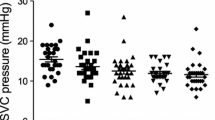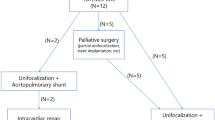Abstract
Single ventricle palliation relies on the pulmonary vasculature accommodating non-pulsatile systemic venous return. Mean pulmonary artery pressure (MPAP) and indexed pulmonary vascular resistance (PVRi) are two measures that impact pulmonary blood flow following bidirectional cavopulmonary connection (BCPC). The purpose of the study was to determine which hemodynamic features are associated with adverse outcomes after BCPC. Pre-operative hemodynamic data and post-operative morbidity and mortality in 250 patients undergoing BCPC at a single center from 2008 to 2014 were reviewed. Patients were then separated into 5 physiologic states based on MPAP, PVRi, and degree of pulmonary to systemic blood flow (Qp:Qs). There were 9 (3.6%) deaths, and 49 patients (20%) sustained major morbidity. An ROC curve identified MPAP > 16 mmHg as an inflection point. Pre-BCPC sildenafil and oxygen use, ventricular dysfunction, and MPAP > 16 mmHg (OR 4.1 [95% CI 1.8–9.2]) were independently associated with morbidity. MPAP > 16 mmHg (OR 6.7 [95% CI 1.6–28]) and pre-BCPC oxygen use were associated with hospital mortality. PVRi was not associated with morbidity or mortality. Of the five physiologic states, patients with high MPAP, low PVRi, and low Qp:Qs fared the worst, with the highest risk of major morbidity (OR 8.6 [3.0–24.9]) and highest risk of mortality (OR 8.0 [1.5–41.3]) when compared to their reference groups (low MPAP, low PVRi). Elevated MPAP, need for pre-operative oxygen support, sildenafil use, and systemic ventricular systolic dysfunction predict morbidity following BCPC. Specifically, patients with elevated MPAP not due to elevated PVRi or pulmonary blood flow had the highest risk of morbidity and mortality.


Similar content being viewed by others
Abbreviations
- MPAP:
-
Mean pulmonary artery pressure
- PVRi:
-
Indexed pulmonary vascular resistance
- BCPC:
-
Bidirectional cavopulmonary connection
- Q p:Q s :
-
Pulmonary to systemic blood flow
- AVVR:
-
Atrioventricular valve regurgitation
- EDP:
-
End-diastolic pressure
- VO2 :
-
Oxygen consumption
- ECMO:
-
Extracorporeal membrane oxygenation
- IQR:
-
Interquartile ranges
- BTS:
-
Blalock–Taussig shunt
References
Bridges ND, Jonas RA, Mayer JE, Flanagan MF, Keane JF, Castaneda AR (1990) Bidirectional cavopulmonary anastomosis as interim palliation for high-risk Fontan candidates. Early Results Circ 82:IV170–IV176
Jonas RA (1994) Indications and timing for the bidirectional Glenn shunt versus the fenestrated Fontan circulation. J Thorac Cardiovasc Surg 108:522–524
Lai L, Laussen PC, Cua CL, Wessel DL, Costello JM, del Nido PJ, Mayer JE, Thiagarajan RR (2007) Outcomes after bidirectional Glenn operation: Blalock–Taussig shunt versus right ventricle-to-pulmonary artery conduit. Ann Thorac Surg 83:1768–1773
Scheurer MA, Hill EG, Vasuki N, Maurer S, Graham EM, Bandisode V, Shirali GS, Atz AM, Bradley SM. Survival after bidirectional cavopulmonary anastomosis: analysis of preoperative risk factors. J Thorac Cardiovasc Surg 2007;134:82–89
Hawkins JA, Shaddy RE, Day RW, Sturtevant JE, Orsmond GS, McGough EC (1993) Mid-term results after bidirectional cavopulmonary shunts. Ann Thorac Surg 56:833–837
Carlo WF, Carberry KE, Heinle JS, Morales DL, McKenzie ED, Fraser CD Jr, Nelson DP (2011) Interstage attrition between bidirectional Glenn and Fontan palliation in children with hypoplastic left heart syndrome. J Thorac Cardiovasc Surg 142:511–516
Friedman KG, Salvin JW, Wypij D, Gurmu Y, Bacha EA, Brown DW, Laussen PC, Scheurer MA (2011) Risk factors for failed staged palliation after bidirectional Glenn in infants who have undergone stage one palliation. Eur J Cardiothorac Surg 40:1000–1006
Lee TM, Aiyagari R, Hirsch JC, Ohye RG, Bove EL, Devaney EJ (2012) Risk factor analysis for second-stage palliation of single ventricle anatomy. Ann Thorac Surg 93:614–618 discussion 619.
Kogon BE, Plattner C, Leong T, Simsic J, Kirshbom PM, Kanter KR (2008) The bidirectional Glenn operation: a risk factor analysis for morbidity and mortality. J Thorac Cardiovasc Surg 136:1237–1242
LaFarge CG, Miettinen OS (1970) The estimation of oxygen consumption. Cardiovasc Resc 4(1):23–30
Alsoufi B, Manlhiot C, Awan A, Alfadley F, Al-Ahmadi M, Al-Wadei A, McCrindle BW, Al-Halees Z (2012) Current outcomes of the Glenn bidirectional cavopulmonary connection for single ventricle palliation. Eur J Cardiothorac Surg 42:42–48
Hussain A, Arfi AM, Hussamuddin M, Haneef AA, Jamjoom A, Al-Ata J, Mo G (2008) Comparative outcome of bidirectional Glenn shunt in patients with pulmonary vascular resistance> or = 3.5 woods units versus < 3.5 woods units. Am J Cardiol 102:907–912
Pridjian AK, Mendelsohn AM, Lupinetti FM, Beekman RH III, Dick M II, Serwer G, Bove EL (1993) Usefulness of the bidirectional Glenn procedure as staged reconstruction for the functional single ventricle. Am J Cardiol 71:959–962
di Carlo D, Williams WG, Freedom RM, Trusler GA, Rowe RD (1982) The role of cava-pulmonary (Glenn) anastomosis in the palliative treatment of congenital heart disease. J Thorac Cardiovasc Surg 83:437–442
Alejos JC, Williams RG, Jarmakani JM, Galindo AJ, Isabel-Jones JB, Drinkwater D, Laks H, Kaplan S (1995) Factors influencing survival in patients undergoing the bidirectional Glenn anastomosis. Am J Cardiol 75:1048–1050
Tanoue Y, Kado H, Boku N, Tatewaki H, Nakano T, Fukae K, Masuda M, Tominaga R (2007) Three hundred and thirty-three experiences with the bidirectional Glenn procedure in a single institute. Interact Cardiovasc Thorac Surg 6:97–101
Silvilairat S, Pongprot Y, Sittiwangkul R, Woragidpoonpol S, Chuaratanaphong S, Nawarawong W (2008) Factors influencing survival in patients after bidirectional Glenn shunt. Asian Cardiovasc Thorac Ann 16:381–386
Friedman KG, Salvin JW, Wypij D, Gurmu Y, Bacha EA, Brown DW, Laussen PC, Scheurer MA (2011) Risk factors for failed stage palliation after bidirectional Glenn in infants who have undergone stage one palliation. Eur J Cardiothorac Surg 40(4):1000–1006
Funding
This study was funded by the Paige Foundation. There is no grant number. Grant recipient is Susanna Tran.
Author information
Authors and Affiliations
Corresponding author
Ethics declarations
Conflict of interest
All authors declare that they have no conflict of interest.
Ethical Approval
This article does not contain any studies with human participants performed by any of the authors.
Rights and permissions
About this article
Cite this article
Tran, S., Sullivan, P.M., Cleveland, J. et al. Elevated Pulmonary Artery Pressure, Not Pulmonary Vascular Resistance, is an Independent Predictor of Short-Term Morbidity Following Bidirectional Cavopulmonary Connection. Pediatr Cardiol 39, 1572–1580 (2018). https://doi.org/10.1007/s00246-018-1932-6
Received:
Accepted:
Published:
Issue Date:
DOI: https://doi.org/10.1007/s00246-018-1932-6




